Analysis of the Drought Mitigated Mechanism in Terraced Paddy Fields Using CWSI and TVDI Indices and Hydrological Monitoring
Abstract
1. Introduction
2. Materials and Methods
2.1. Study Area
2.1.1. Location
2.1.2. Terraced Paddy Fields
2.2. Analysis and Measurements
2.2.1. Watershed Drought Analysis
- a
- Data
- b
- Drought Indices
2.2.2. Observation of Hydrology of Terraced Paddies
3. Results
3.1. LST Trend with ENSO Phenomena
3.2. Spatio-Temporal Pattern of CWSI and TVDI
3.3. Drought Analysis in the Representative Grid Cell
3.4. Hydrological Monitoring Results
4. Discussion
4.1. Drought and Its Relation to ENSO
4.2. CWSI and TVDI in Terraced Paddies
4.3. Influence of Hydrology on Drought in Terraced Paddies
5. Conclusions
Author Contributions
Funding
Acknowledgments
Conflicts of Interest
References
- Badan Nasional Penanggulangan Bencana. Indonesia: National Action Plan for Disaster Risk Reduction 2010–2012; Badan Nasional Penanggulangan Bencana: Jakarta, Indonesia, 2012.
- Mursidi, A.; Sari, D.A.P. Management of disaster drought in Indonesia. J. Appl. Manag. Bus. 2017, 3, 165–171. [Google Scholar]
- D’Arrigo, R.; Wilson, R.; Palmer, J.; Krusic, P.; Curtis, A.; Sakulich, J.; Bijaksana, S.; Zulaikah, S.; Ngkoimani, L.O. Monsoon drought over Java, Indonesia, during the past two centuries. Geophys. Res. Lett. 2006, 33, L04709. [Google Scholar] [CrossRef]
- D’Arrigo, R.; Wilson, R. El Niño and Indian Ocean influences on Indonesian drought: Implications for forecasting rainfall and crop productivity. Int. J. Climatol. 2008, 28, 611–616. [Google Scholar] [CrossRef]
- D’Arrigo, R.; Smerdon, J.E. Tropical climate influences on drought variability over Java, Indonesia. Geophys. Res. Lett. 2008, 35, L05707. [Google Scholar] [CrossRef]
- Tangang, F.; Salimun, E.; Aldrian, E.; Sopaheluwakan, A.; Juneng, L. ENSO modulation of seasonal rainfall and extremes in Indonesia. Clim. Dyn. 2018, 51, 2559–2580. [Google Scholar] [CrossRef]
- Hamada, J.-I.; Yamanaka, M.D.; Matsumoto, J.; Fukao, S.; Winarso, P.A.; Sribimawati, T. Spatial and temporal variations of the rainy season over Indonesia and their link to ENSO. J. Meteorol. Soc. Jpn. 2004, 80, 285–310. [Google Scholar] [CrossRef]
- Nugroho, B.D.A.; Nuraini, L. Cropping pattern scenario based on global climate indices and rainfall in banyumas district, central java, Indonesia. Agric. Agric. Sci. Procedia 2016, 9, 54–63. [Google Scholar] [CrossRef]
- Nugroho, B.D.A.; Toriyama, K.; Kobayashi, K.; Arif, C.; Yokoyama, S.; Mizoguchi, M. Effect of intermittent irrigation following the system of rice intensification (SRI) on rice yield in a farmer’s paddy fields in Indonesia. Paddy Water Environ. 2018, 16, 715–723. [Google Scholar] [CrossRef]
- Muthayya, S.; Sugimoto, J.D.; Montgomery, S.; Maberly, G.F. An overview of global rice production, supply, trade, and consumption. Ann. N. Y. Acad. Sci. 2014, 1324, 7–14. [Google Scholar] [CrossRef]
- FAO. FAO Rice Market Monitor; FAO: Rome, Italy, 2015; Vol. XVIII. [Google Scholar]
- Razali, I.A.; Hanum, H. Identification of nutritional status and paddy production in paddy field terracing and non terracing system in Onan Rungu Subdistrict, District of Samosir. J. Agroekoteknol. 2017, 5, 338–347. (In Indonesian) [Google Scholar]
- Thenkabail, P.S.; Gamage, M.S.D.N.; Smakhtin, V.U. The Use of Remote Sensing Data for Drought Assessment and Monitoring in Southwest Asia; IWMI: Colombo, Sri Lanka, 2004. [Google Scholar]
- Son, N.T.; Chen, C.F.; Chen, C.R.; Chang, L.Y.; Minh, V.Q. Monitoring agricultural drought in the lower mekong basin using MODIS NDVI and land surface temperature data. Int. J. Appl. Earth Obs. Geoinf. 2012, 18, 417–427. [Google Scholar] [CrossRef]
- Rachid, S.; Bennett, J.; Hardy, B.; International Rice Research Institute. Drought Frontiers in Rice: Crop Improvement for Increased Rainfed Production; IRRI: Los Baños, Philippines, 2008; ISBN 978-971-22-0237-7. [Google Scholar]
- USGS Droughts: Things to Know. Available online: https://www.usgs.gov/special-topic/water-science-school/science/droughts-things-know?qt-science_center_objects=0#qt-science_center_objects (accessed on 2 November 2019).
- Svoboda, M.; Fuchs, B.A. Handbook of Drought Indicators and Indices; World Meteorological Organization (WMO) and Global Water Partnership (GWP): Geneva, Switzerland, 2016. [Google Scholar]
- Kogan, F. World droughts in the new millennium from AVHRR-based vegetation health indices. Eos Trans. Am. Geophys. Union 2002, 83, 557–563. [Google Scholar] [CrossRef]
- Mishra, A.K.; Singh, V.P. A review of drought concepts. J. Hydrol. 2010, 391, 202–216. [Google Scholar] [CrossRef]
- Carrão, H.; Russo, S.; Sepulcre-Canto, G.; Barbosa, P. An empirical standardized soil moisture index for agricultural drought assessment from remotely sensed data. Int. J. Appl. Earth Obs. Geoinf. 2016, 48, 74–84. [Google Scholar] [CrossRef]
- Sruthi, S.; Mohammed Aslam, M. Agricultural drought analysis using the NDVI and land surface temperature data; a case study of Raichur district. Aquat. Procedia 2015, 4, 1258–1264. [Google Scholar] [CrossRef]
- Khomarudin, M.R.; Sofan, P. Crop Water Stress Index (CWSI) estimation using MODIS data. Int. J. Remote Sens. Earth Sci. IJReSES 2018, 3, 80–84. [Google Scholar] [CrossRef][Green Version]
- Idso, S.B.; Jackson, R.D.; Pinter, P.J.; Reginato, R.J.; Hatfield, J.L. Normalizing the stress-degree-day parameter for environmental variability. Agric. Meteorol. 1981, 24, 45–55. [Google Scholar] [CrossRef]
- Jackson, R.D.; Idso, S.B.; Reginato, R.J.; Pinter, P.J. Canopy temperature as a crop water stress indicator. Water Resour. Res. 1981, 17, 1133–1138. [Google Scholar] [CrossRef]
- Andrews, P.K.; Chalmers, D.J.; Moremong, M. Canopy-Air Temperature Differences and Soil Water as Predictors of Water Stress of Apple Trees Grown in a Humid, Temperate Climate. J. Am. Soc. Hortic. Sci. 1992, 117, 453–458. [Google Scholar] [CrossRef]
- Pou, A.; Diago, M.P.; Medrano, H.; Baluja, J.; Tardaguila, J. Validation of thermal indices for water status identification in grapevine. Agric. Water Manag. 2014, 134, 60–72. [Google Scholar] [CrossRef]
- Xu, J.; Lv, Y.; Liu, X.; Dalson, T.; Yang, S.; Wu, J. Diagnosing crop water stress of rice using infra-red thermal imager under water deficit condition. Int. J. Agric. Biol. 2016, 18, 565–572. [Google Scholar] [CrossRef]
- Taghvaeian, S.; Chávez, J.L.; Altenhofen, J.; Trouth, T.; DeJonge, K. Remote sensing for evaluating crop waterstress at field scale using infrared thermography: Potential and limitations. Hydrol. Days. 2013, 4, 74–83. [Google Scholar]
- Bai, J.; Yu, Y.; Di, L. Comparison between TVDI and CWSI for drought monitoring in the Guanzhong Plain, China. J. Integr. Agric. 2017, 16, 389–397. [Google Scholar] [CrossRef]
- Wu, H.; Xiong, D.; Liu, B.; Zhang, S.; Yuan, Y.; Fang, Y.; Chidi, C.L.; Dahal, N.M. Spatio-temporal analysis of drought variability using CWSI in the Koshi River Basin (KRB). Int. J. Environ. Res. Public Health 2019, 16, 3100. [Google Scholar] [CrossRef]
- Sandholt, I.; Rasmussen, K.; Andersen, J. Derivation of a dryness index from NOAA-AVHRR data for use in large-scale hydrological modelling. In Remote Sensing and Hydrology 2000; International Assn of Hydrological Sciences: Wallingford, UK, 2001; pp. 212–216. [Google Scholar]
- Nur’utami, M.N.; Hidayat, R. Influences of IOD and ENSO to Indonesian rainfall variability: Role of atmosphere-ocean interaction in the indo-pacific sector. Procedia Environ. Sci. 2016, 33, 196–203. [Google Scholar] [CrossRef]
- The Jakarta Post. Prolonged Drought Drains Dams, Halts Electricity Supplies. Available online: https://www.thejakartapost.com/news/2015/11/03/prolonged-drought-drains-dams-halts-electricity-supplies.html (accessed on 2 August 2019).
- Shimpei, A. Agricultural Technologies of Terraced Rice Cultivation in the Ailao Mountains, Yunnan, China. Asian Afr. Area Stud. 2007, 6, 173–196. [Google Scholar]
- Busetto, L.; Ranghetti, L. MODIStsp: An R package for automatic preprocessing of MODIS land products time series. Comput. Geosci. 2016, 97, 40–48. [Google Scholar] [CrossRef]
- Jackson, R.D.; Kustas, W.P.; Choudhury, B.J. A reexamination of the crop water stress index. Irrig. Sci. 1988, 9, 309–317. [Google Scholar] [CrossRef]
- Mu, Q. Algorithm Theoretical Basis Document: MODIS Global Terrestrial Evapotranspiration (ET) Product (NASA MOD16A2/A3) Collection 5; Nasa Headquarters: Washington, DC, USA, 2013.
- Running, S.W.; Mu, Q.; Zhao, M.; Moreno, A. MOD16A2 MODIS/Terra Net Evapotranspiration 8-Day L4 Global 500m SIN Grid V006. NASA EOSDIS Land Processes DAAC, 2017. Available online: https://lpdaac.usgs.gov/products/mod16a2v006/ (accessed on 25 April 2019). [CrossRef]
- Velpuri, N.M.; Senay, G.B.; Singh, R.K.; Bohms, S.; Verdin, J.P. A comprehensive evaluation of two MODIS evapotranspiration products over the conterminous United States: Using point and gridded FLUXNET and water balance ET. Remote Sens. Environ. 2013, 139, 35–49. [Google Scholar] [CrossRef]
- Buyadi, S.N.A.; Mohd, W.M.N.W.; Misni, A. Impact of land use changes on the surface temperature distribution of area surrounding the National Botanic Garden, Shah Alam. Procedia Soc. Behav. Sci. 2013, 101, 516–525. [Google Scholar] [CrossRef]
- Kumar, P.; Husain, A.; Singh, R.B.; Kumar, M. Impact of land cover change on land surface temperature: A case study of Spiti Valley. J. Mt. Sci. 2018, 15, 1658–1670. [Google Scholar] [CrossRef]
- Sun, Q.; Wu, Z.; Tan, J. The relationship between land surface temperature and land use/land cover in Guangzhou, China. Environ. Earth Sci. 2012, 65, 1687–1694. [Google Scholar] [CrossRef]
- Davey, M.K.; Brookshaw, A.; Ineson, S. The probability of the impact of ENSO on precipitation and near-surface temperature. Clim. Risk Manag. 2014, 1, 5–24. [Google Scholar] [CrossRef]
- Matsumoto, J. Seasonal transition of summer rainy season over indochina and adjacent monsoon region. Adv. Atmospheric Sci. 1997, 14, 231–245. [Google Scholar] [CrossRef]
- Liu, C.-W.; Huang, H.-C.; Chen, S.-K.; Kuo, Y.-M. Subsurface return flow and groundwater recharge of terrace fields in Northern Taiwan. J. Am. Water Resour. Assoc. 2004, 40, 603–614. [Google Scholar] [CrossRef]
- Huang, H.-C.; Liu, C.-W.; Chen, S.-K.; Chen, J.-S. Analysis of percolation and seepage through paddy bunds. J. Hydrol. 2003, 284, 13–25. [Google Scholar] [CrossRef]
- FAO. 2015–2016 El Niño—Early Action and Response for Agriculture, Food Security and Nutrition; FAO: Rome, Italy, 2016. [Google Scholar]
- Onishi, T.; Nakamura, K.; Horino, H.; Adachi, T.; Mitsuno, T. Evaluation of the denitrification rate of terraced paddy fields. J. Hydrol. 2012, 436, 111–119. (In Japanese) [Google Scholar] [CrossRef]
- Srikantha, H.; Archana, J. Rice Terrace Farming Systems Rice Terrace Farming Systems Working Paper Series Study of Institutional and Governance Arrangements for Achieving Water Security in the Hani Rice Terraces; United Nations University (UNU): Tokyo, Japan, 2015. [Google Scholar]
- Lang, A.R.G.; Evans, G.N.; Ho, P.Y. The influence of local advection on evapotranspiration from irrigated rice in a semi-arid region. Agric. Meteorol. 1974, 13, 5–13. [Google Scholar] [CrossRef]
- Baldocchi, D.; Knox, S.; Dronova, I.; Verfaillie, J.; Oikawa, P.; Sturtevant, C.; Matthes, J.H.; Detto, M. The impact of expanding flooded land area on the annual evaporation of rice. Agric. For. Meteorol. 2016, 223, 181–193. [Google Scholar] [CrossRef]

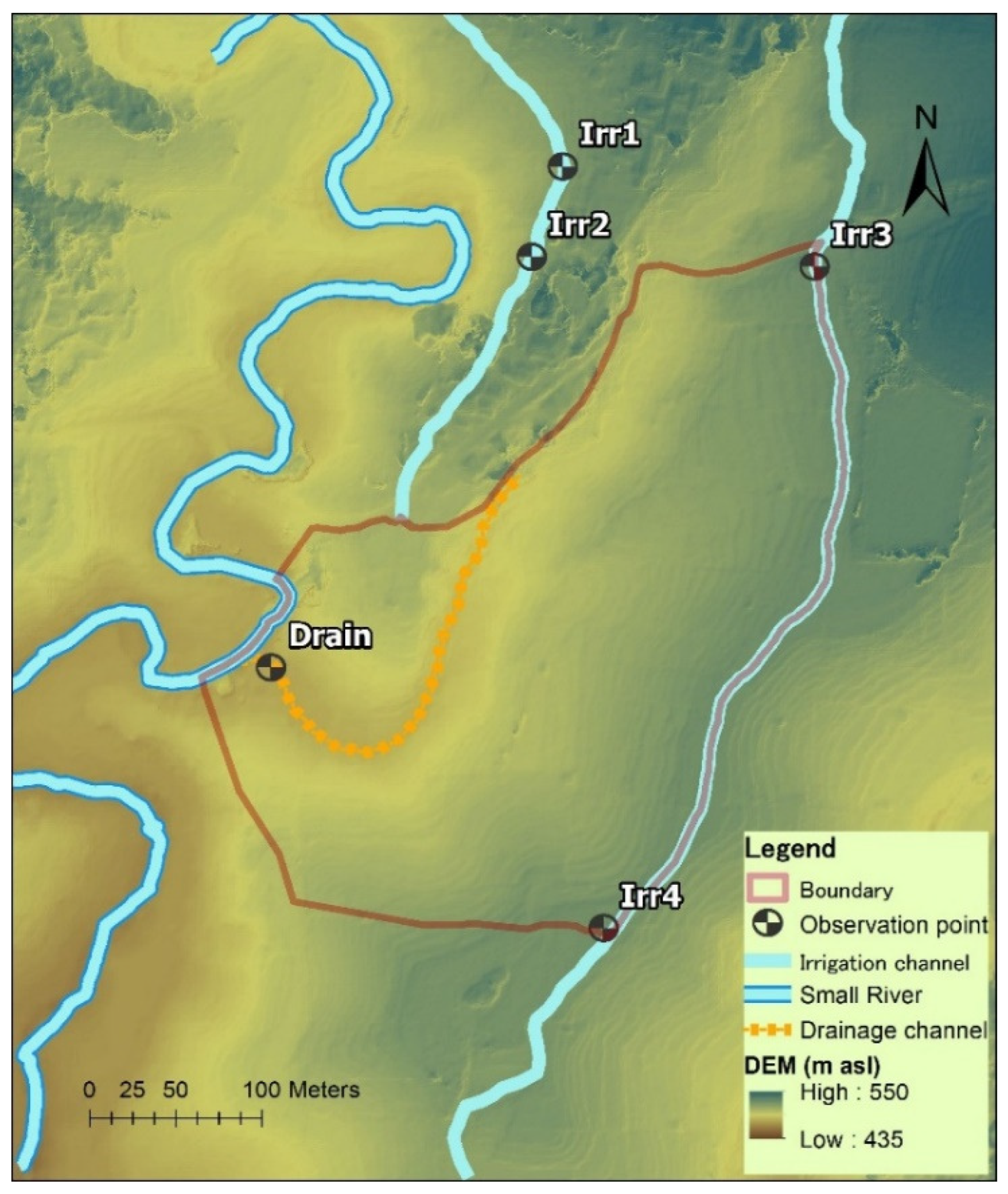
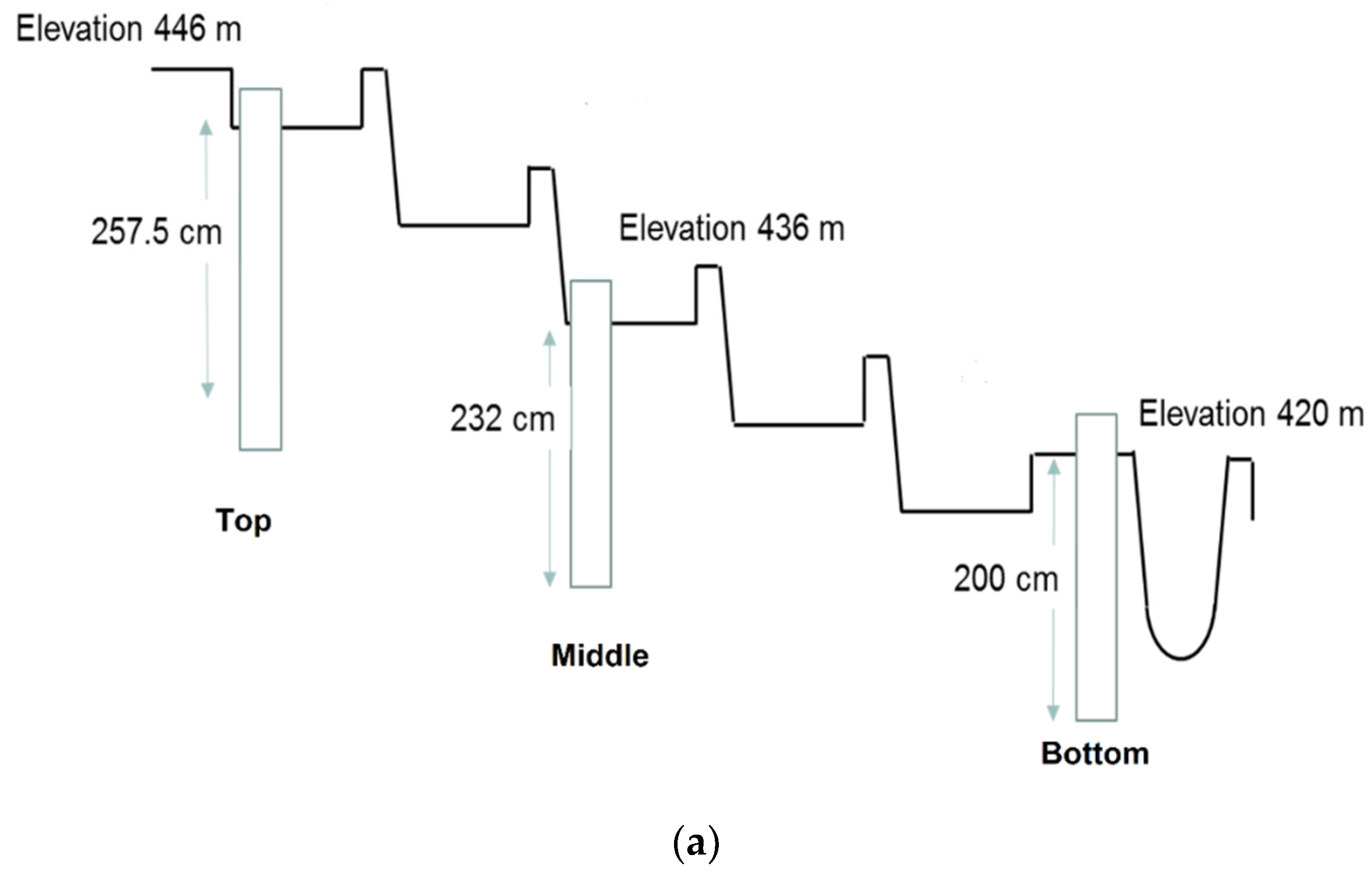
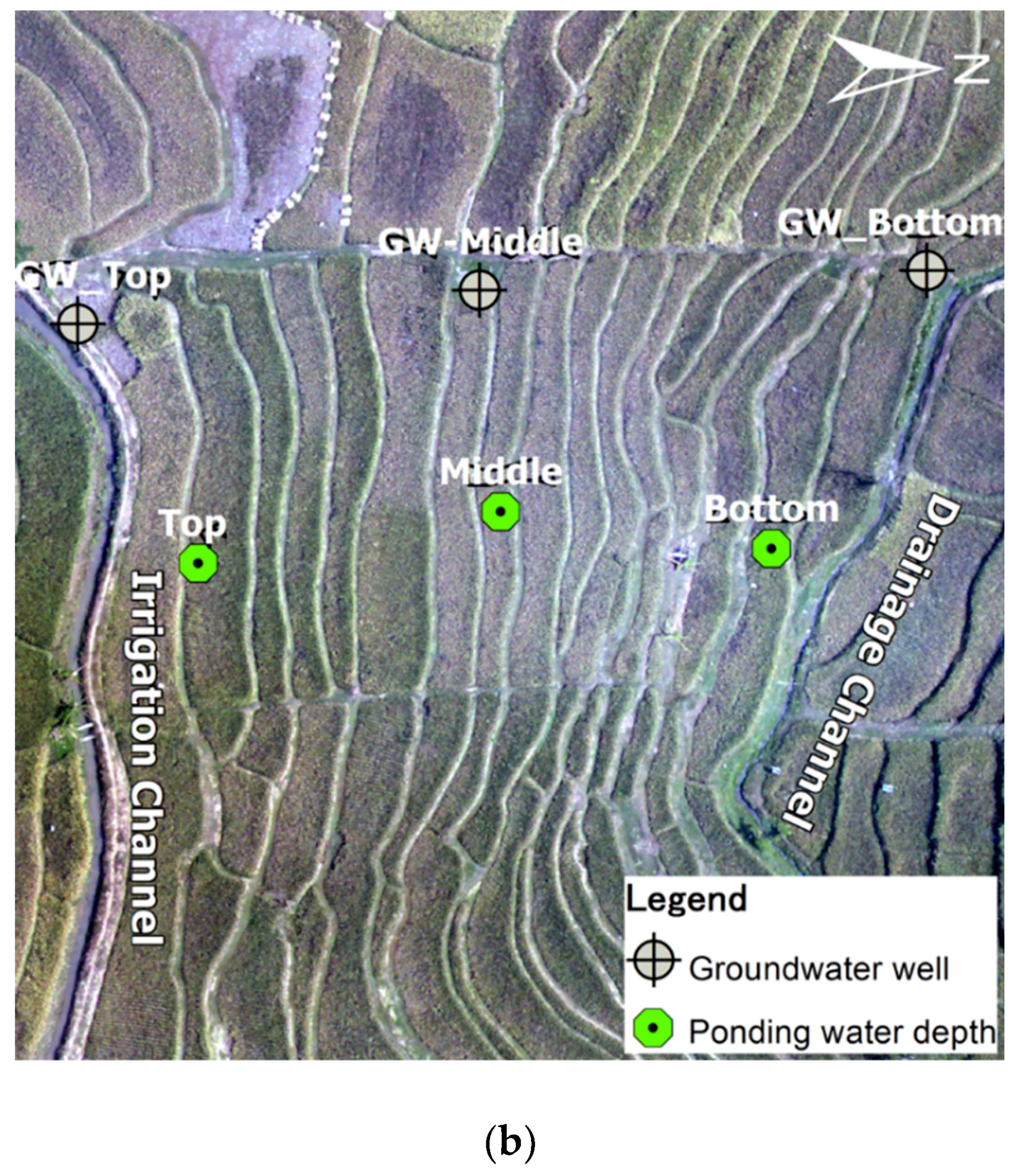
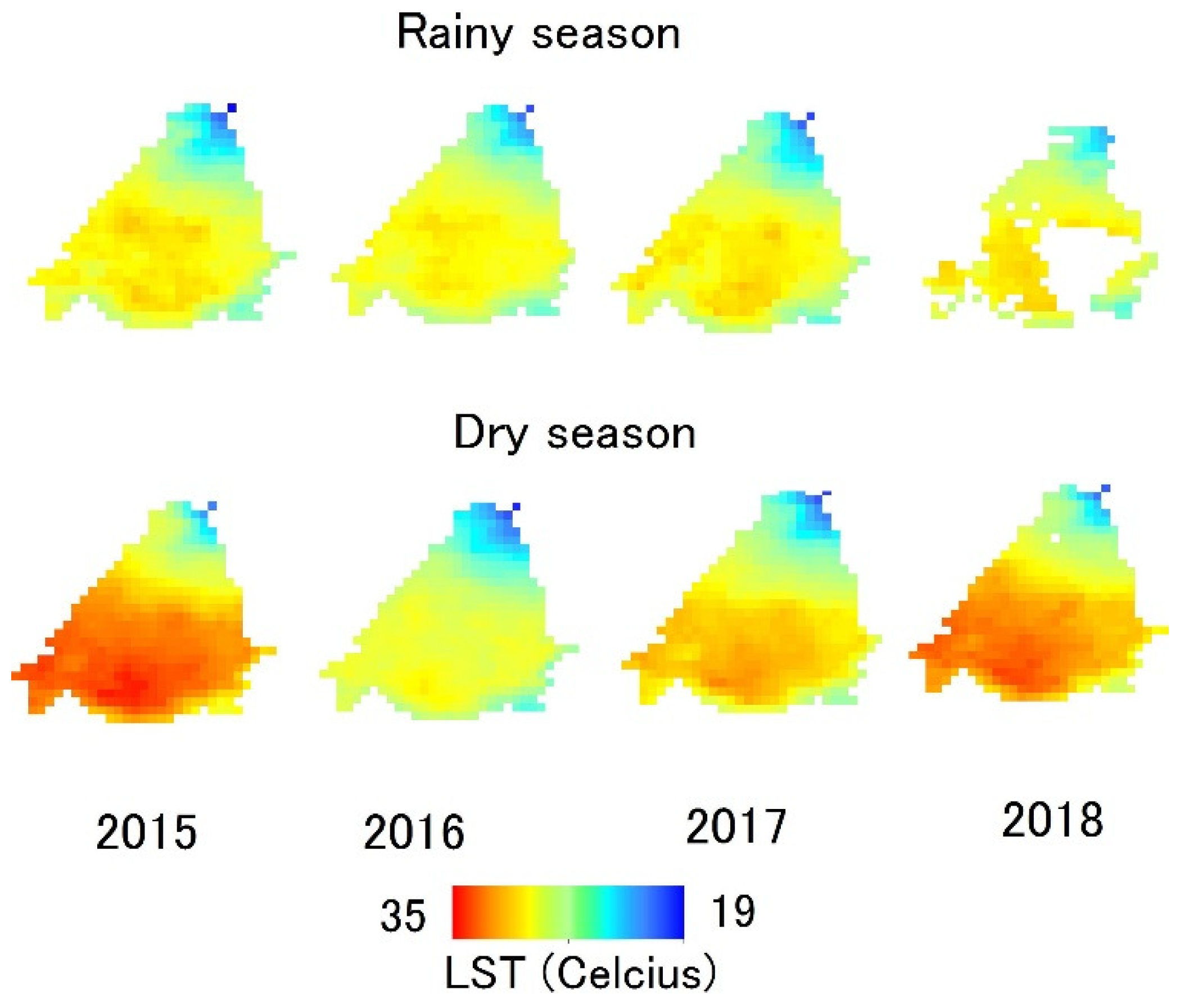

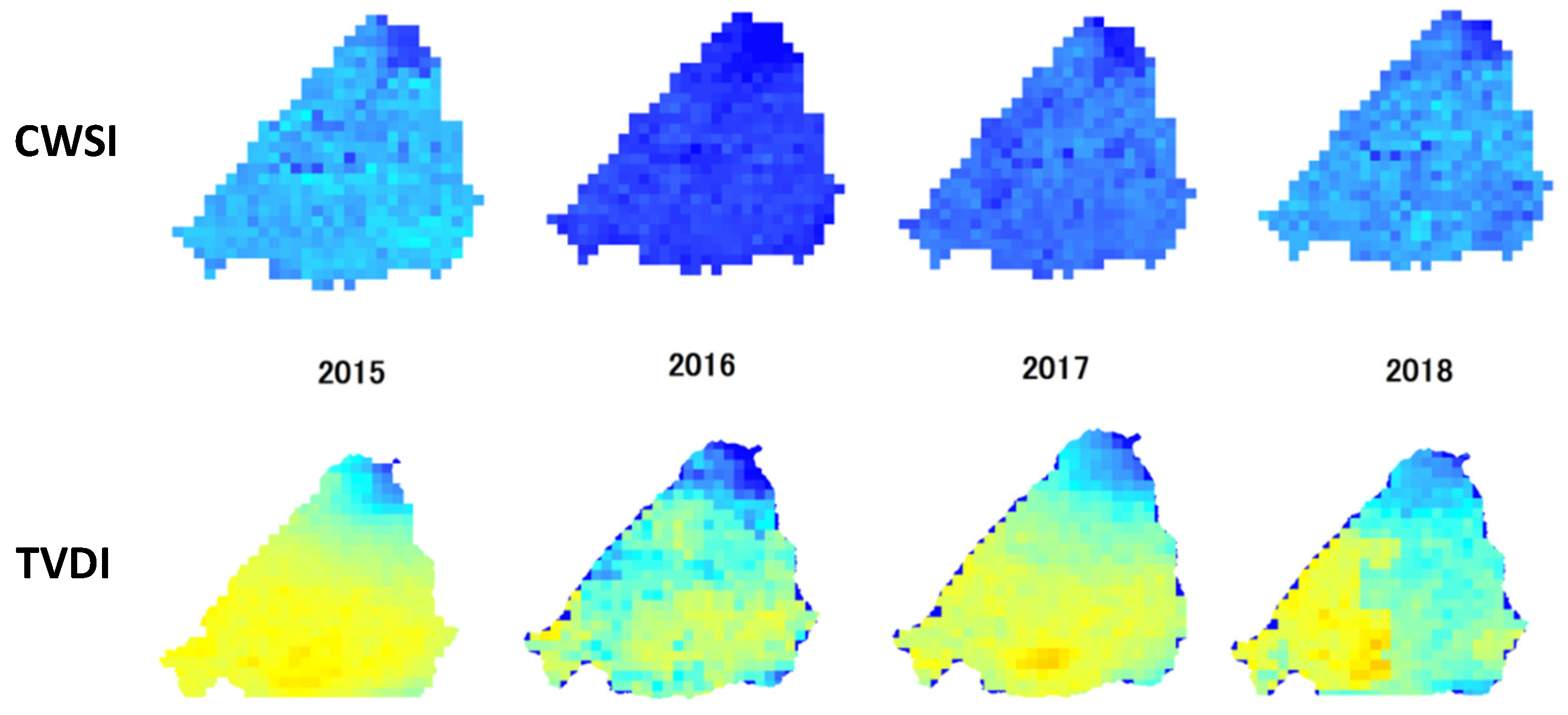
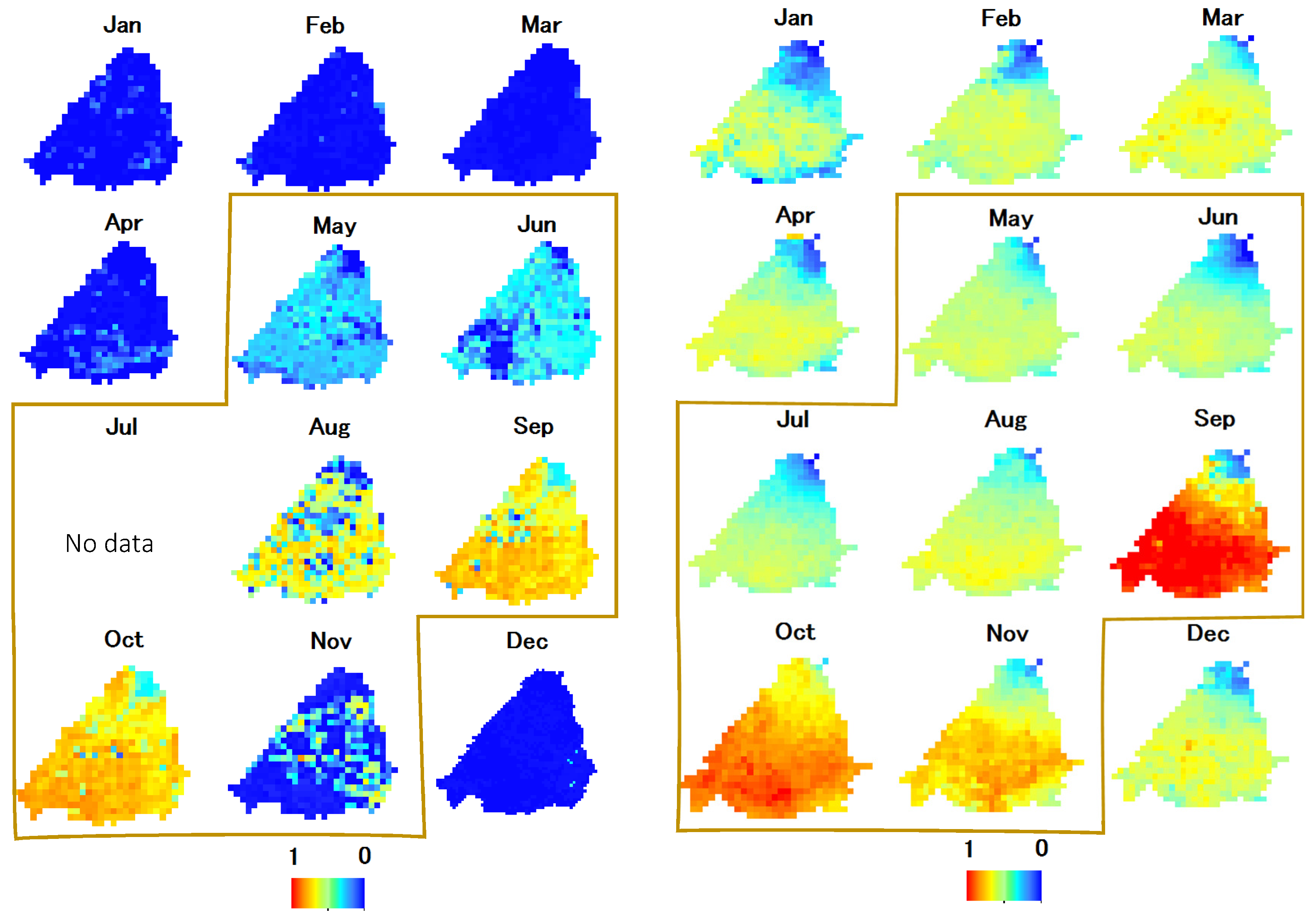
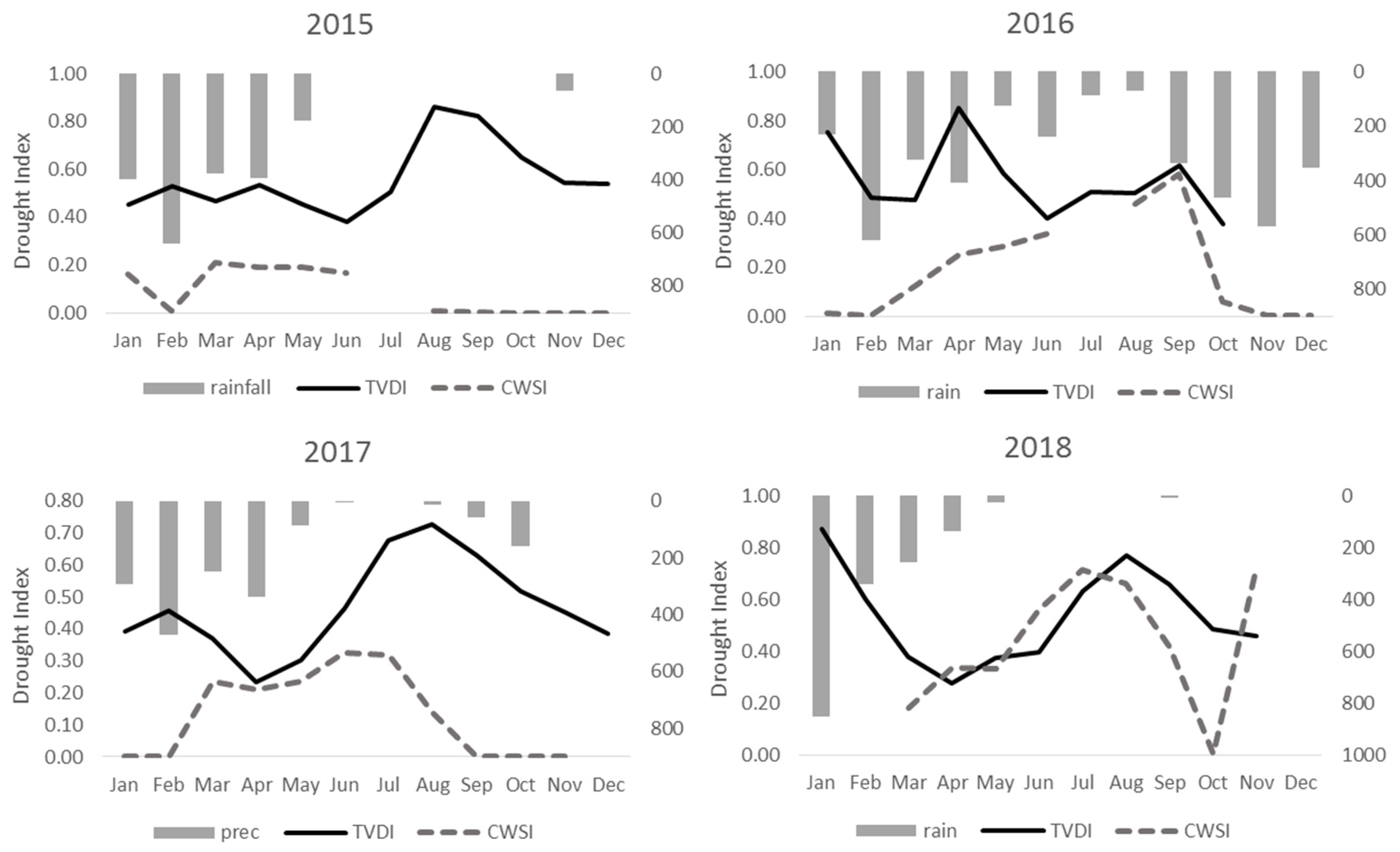
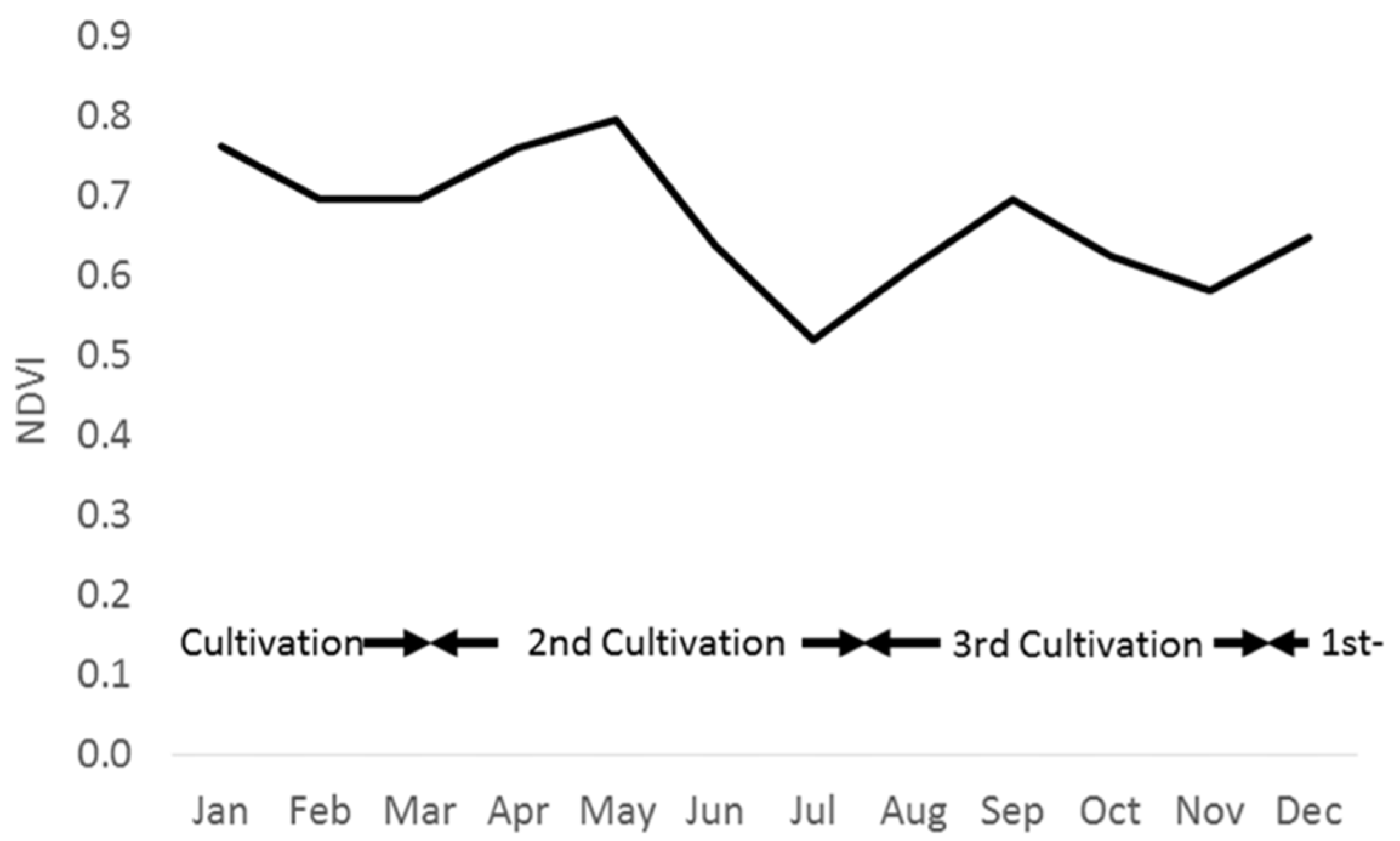
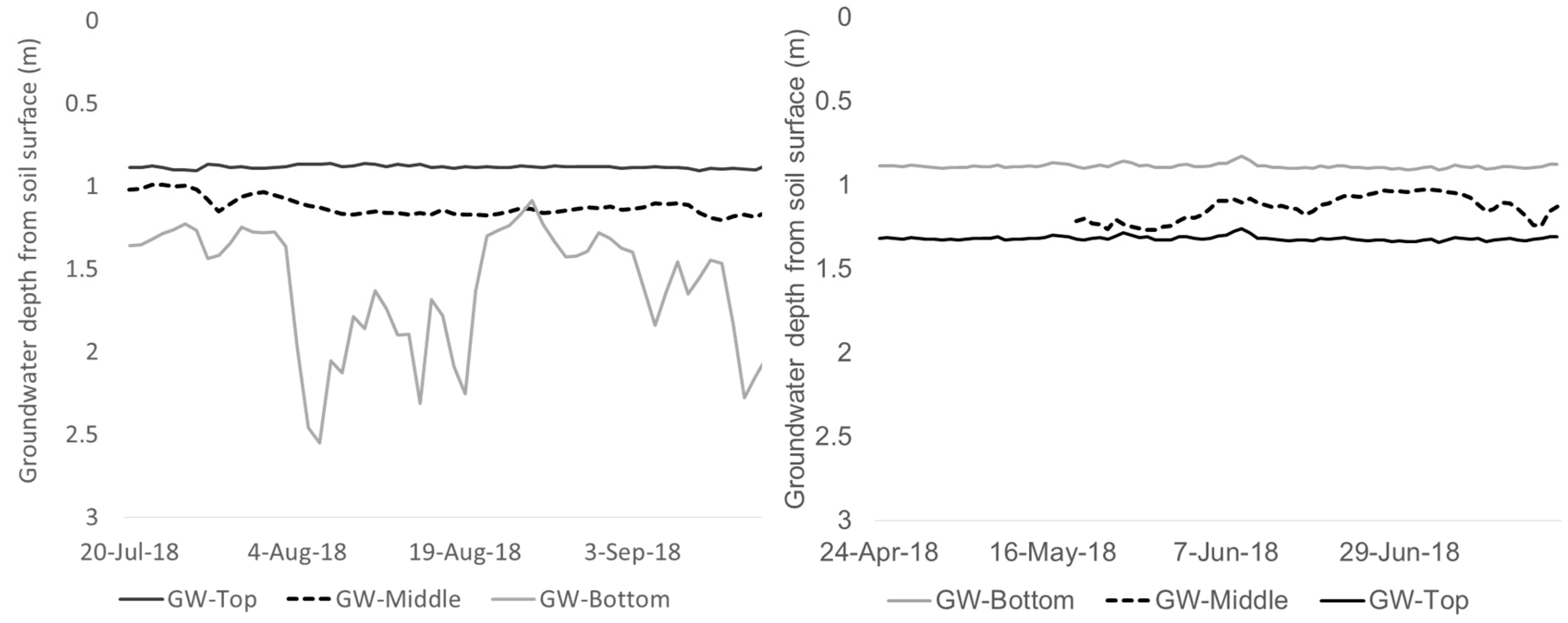
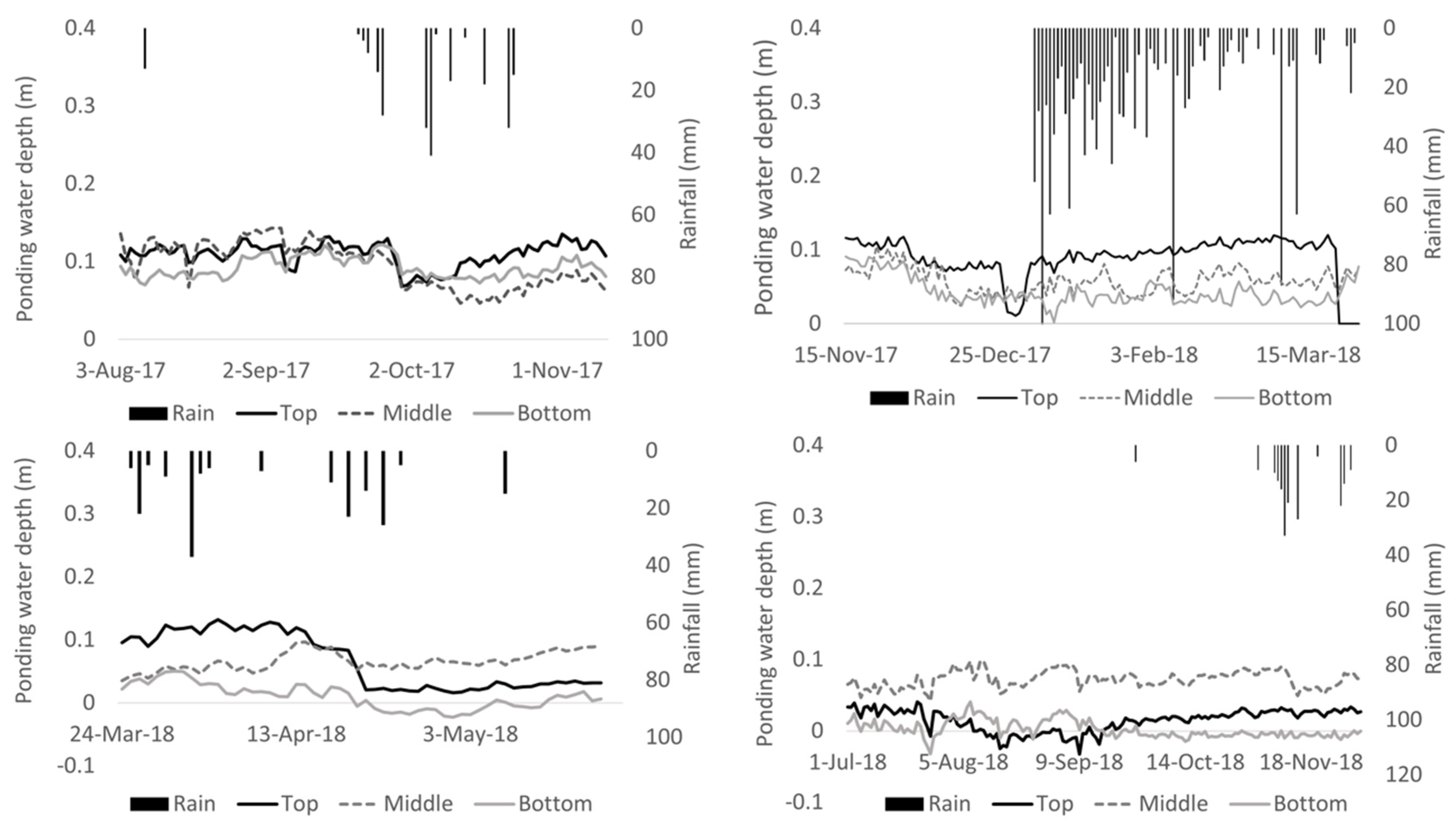
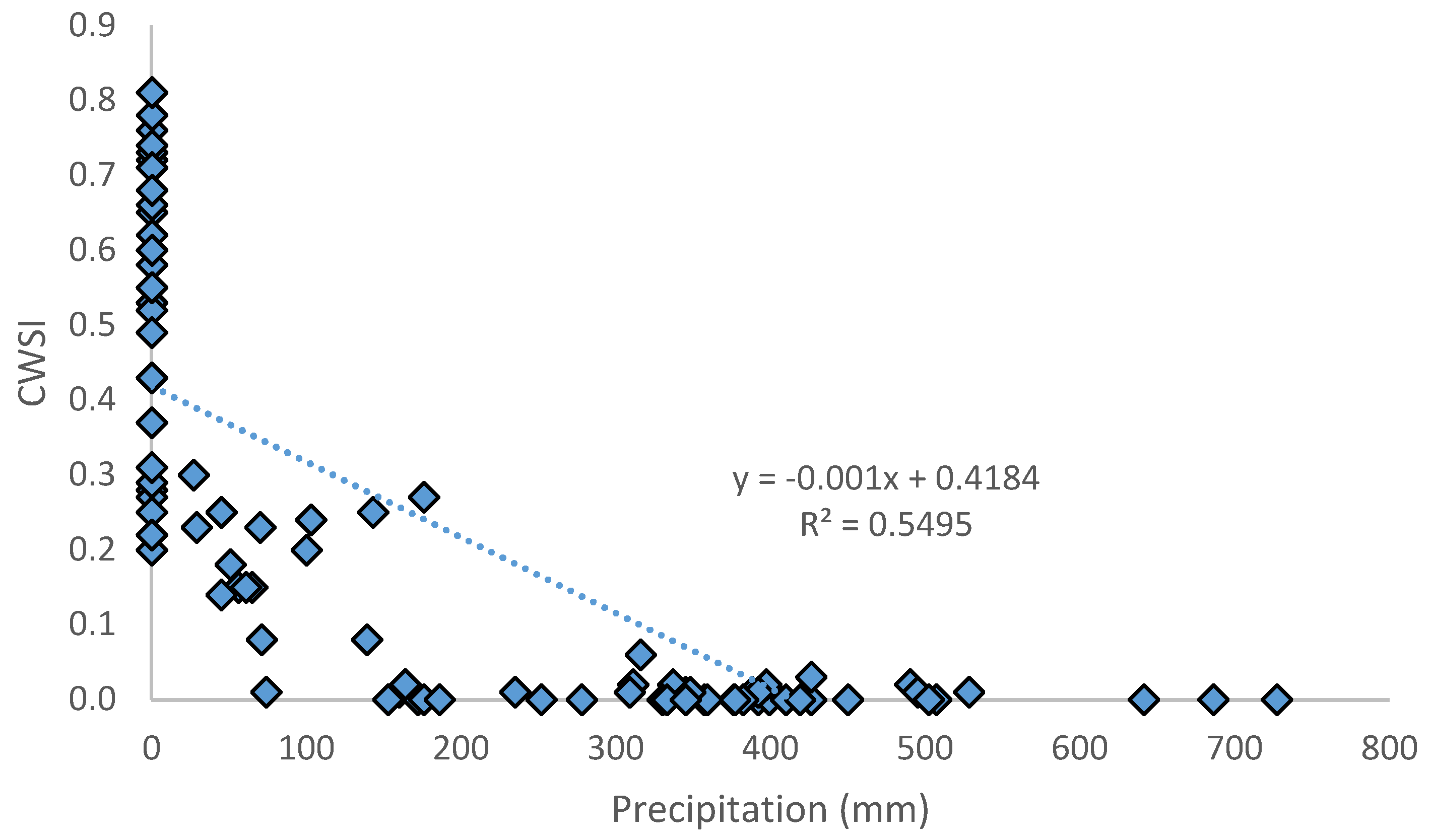
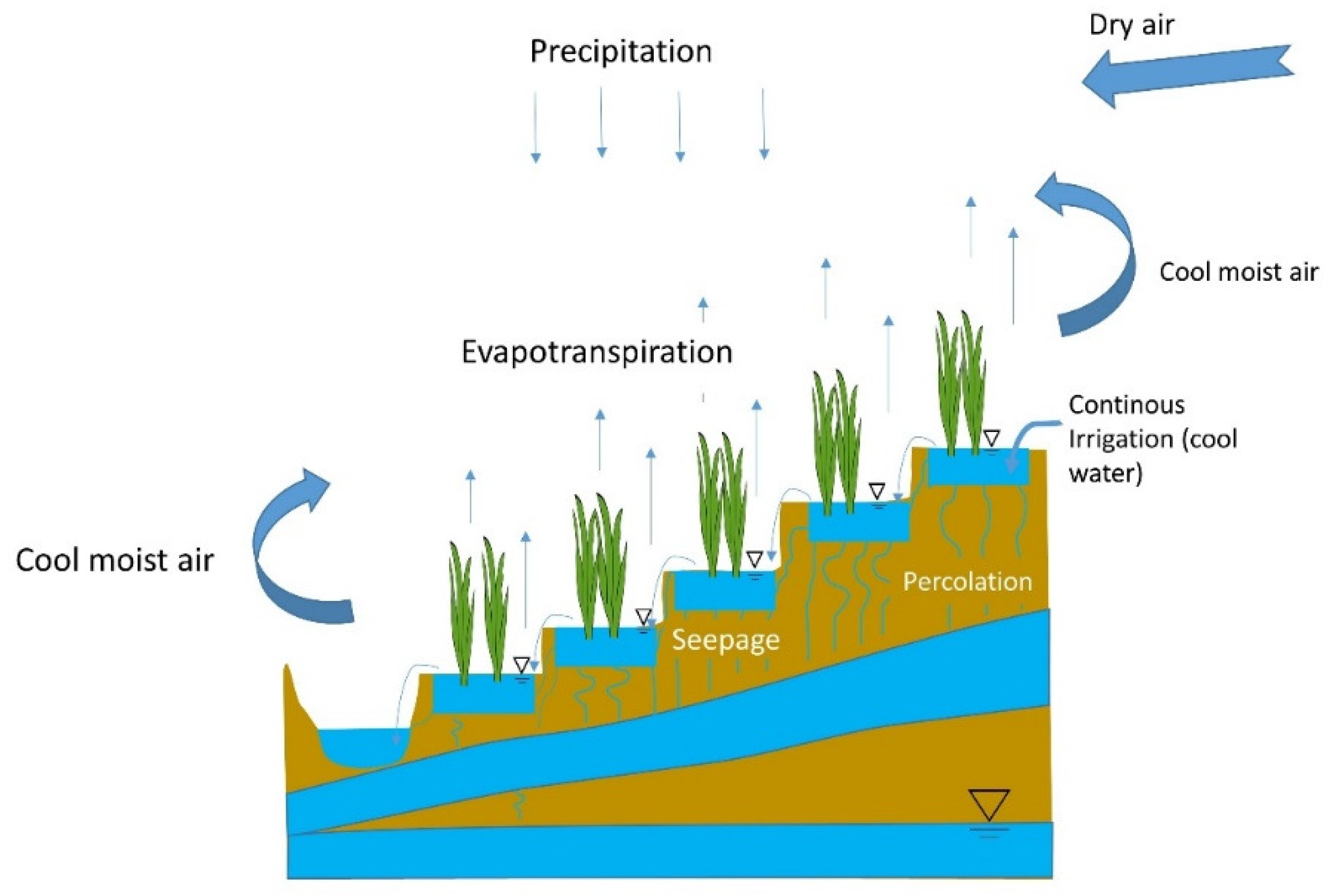
| CWSI | ENSO Condition | |||||
|---|---|---|---|---|---|---|
| 0–0.25 | 0.25–0.5 | 0.5–0.75 | 0.75–1 | |||
| Rainy season | 2015 | 95.9 | 0 | 0 | 0 | Strong El Niño |
| 2016 | 99.0 | 0 | 0 | 0 | La Niña | |
| 2017 | 95.2 | 0 | 0 | 0 | Normal | |
| 2018 | 99.1 | 0 | 0 | 0 | Moderate El Niño | |
| Dry Season | 2015 | 4.9 | 84.0 | 11.1 | 0 | Strong El Niño |
| 2016 | 94.8 | 1.6 | 0 | 0 | La Niña | |
| 2017 | 32.1 | 67.7 | 0 | 0 | Normal | |
| 2018 | 12.1 | 87.4 | 0.5 | 0 | Moderate El Niño | |
| TVDI | ENSO Condition | |||||
|---|---|---|---|---|---|---|
| 0–0.25 | 0.25–0.5 | 0.5–0.75 | 0.75–1 | |||
| Rainy season | 2015 | 6.1 | 32.2 | 60.8 | 0 | Strong El Niño |
| 2016 | 4.7 | 27.7 | 63.2 | 3.3 | La Niña | |
| 2017 | 13.9 | 40.8 | 42.3 | 0 | Normal | |
| 2018 | 25.8 | 41.3 | 32.1 | 0 | Moderate El Niño | |
| Dry Season | 2015 | 2.5 | 14.0 | 81.0 | 1.8 | Strong El Niño |
| 2016 | 5.5 | 12.4 | 80.1 | 1.1 | La Niña | |
| 2017 | 5.4 | 23.5 | 63.8 | 6.5 | Normal | |
| 2018 | 1.8 | 25.8 | 71.9 | 0 | Moderate El Niño | |
| January | February | March | April | May | June | July | August | September | October | November | December | |
|---|---|---|---|---|---|---|---|---|---|---|---|---|
| 2015 | 17.3 | 49.3 | 26.9 | 24.5 | 29.3 | 0 | 0 | 0 | 0 | 0 | 13.0 | 17.4 |
| 2016 | 16.5 | 28.2 | 16.3 | 20.4 | 17.6 | 19.8 | 11 | 14.2 | 26.0 | 27.2 | 21.9 | 22.2 |
| 2017 | 19.6 | 23.6 | 18.9 | 22.5 | 21.5 | 6 | 0 | 13 | 11.2 | 20 | 0 | 0 |
| 2018 | 116 | 92 | 87 | 37 | 15 | 0 | 0 | 0 | 6 | 0 | 17.8 | 27.1 |
| Component. | Water Amount (mm) |
|---|---|
| Precipitation | 0 |
| Irrigation | 2057.8 |
| Evapotranspiration | 649.4 |
| Percolation and ΔS * | 676.4 |
| Drainage | 732.0 |
| Rice Yield (ton/ha) | Harvested Area (×103 ha) | |
|---|---|---|
| 2015 | 6.05 | 19.18 |
| 2016 | 5.88 | 17.42 |
| 2017 | 6.08 ** | 12.12 ** |
© 2019 by the authors. Licensee MDPI, Basel, Switzerland. This article is an open access article distributed under the terms and conditions of the Creative Commons Attribution (CC BY) license (http://creativecommons.org/licenses/by/4.0/).
Share and Cite
Fitriyah, A.; Fatikhunnada, A.; Okura, F.; Nugroho, B.D.A.; Kato, T. Analysis of the Drought Mitigated Mechanism in Terraced Paddy Fields Using CWSI and TVDI Indices and Hydrological Monitoring. Sustainability 2019, 11, 6897. https://doi.org/10.3390/su11246897
Fitriyah A, Fatikhunnada A, Okura F, Nugroho BDA, Kato T. Analysis of the Drought Mitigated Mechanism in Terraced Paddy Fields Using CWSI and TVDI Indices and Hydrological Monitoring. Sustainability. 2019; 11(24):6897. https://doi.org/10.3390/su11246897
Chicago/Turabian StyleFitriyah, Atiqotun, Alvin Fatikhunnada, Fumi Okura, Bayu Dwi Apri Nugroho, and Tasuku Kato. 2019. "Analysis of the Drought Mitigated Mechanism in Terraced Paddy Fields Using CWSI and TVDI Indices and Hydrological Monitoring" Sustainability 11, no. 24: 6897. https://doi.org/10.3390/su11246897
APA StyleFitriyah, A., Fatikhunnada, A., Okura, F., Nugroho, B. D. A., & Kato, T. (2019). Analysis of the Drought Mitigated Mechanism in Terraced Paddy Fields Using CWSI and TVDI Indices and Hydrological Monitoring. Sustainability, 11(24), 6897. https://doi.org/10.3390/su11246897






